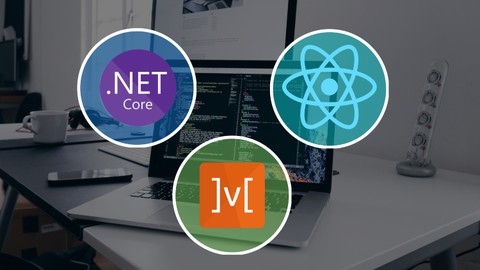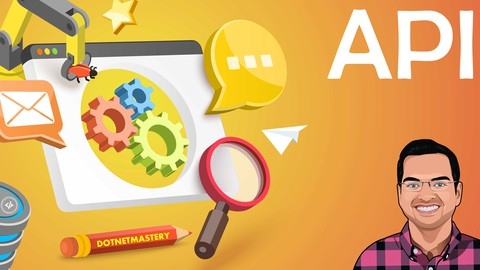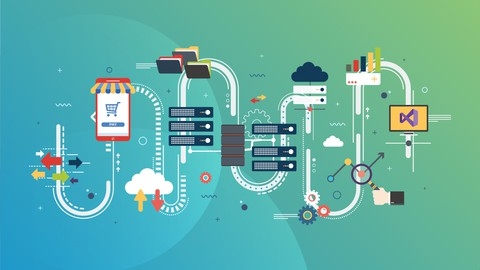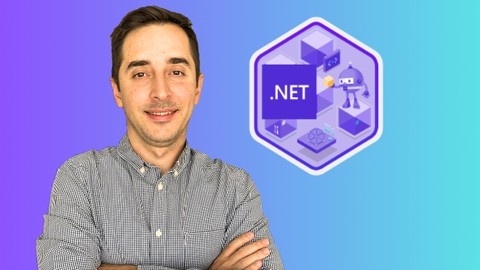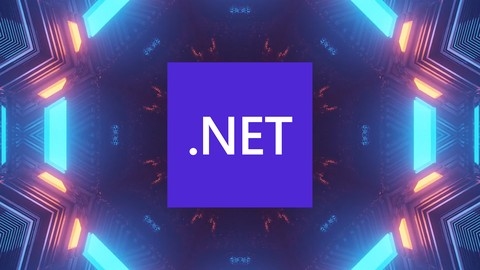.NET Core MVC - The Complete Guide 2023 [E-commerce] [.NET8]
You’ll start by setting up your development environment and creating a new .NET Core MVC project.
The course covers the fundamentals of MVC architecture, routing, and dependency injection, ensuring you have a solid grasp of the core concepts.
The real fun begins with implementing CRUD (Create, Read, Update, Delete) operations for categories and products.
You’ll learn how to work with Entity Framework Core, create data models, handle server-side and client-side validations, and design user interfaces using Bootstrap.
As you progress, the course dives into more advanced topics like implementing the Repository Pattern and Unit of Work, which promotes code reusability and maintainability.
You’ll also explore areas in .NET, allowing you to organize your application’s functionality into logical modules.
The course covers user authentication and authorization using ASP.NET Core Identity, including registering users, creating roles, and securing specific areas of your application based on user roles.
Building an e-commerce application wouldn’t be complete without a shopping cart implementation.
You’ll learn how to add products to the cart, update quantities, and calculate order totals dynamically.
When it’s time to place an order, the course guides you through integrating with Stripe for secure online payments.
You’ll also implement order management features, allowing users to view their order history and update order statuses.
Throughout the course, you’ll explore advanced concepts like view components, social logins (Facebook, Microsoft), and session management.
The deployment process is covered in detail, including setting up a production database, configuring SendGrid for email notifications, and deploying your application to Azure.
User management is another crucial aspect covered, where you’ll learn how to display user lists, manage user roles, and lock/unlock user accounts.
The course even delves into handling multiple product images, utilizing techniques like file uploads and carousels for an enhanced user experience.
Design Patterns in C# and .NET
This course goes from the fundamental SOLID principles to specific patterns like Singleton, Builder, Factory, Adapter, and many more.
The course starts by laying the groundwork with SOLID design principles that promote good software design practices.
It then dives into creational patterns like Builder, Factory methods, Singleton, and Prototype to learn how to properly instantiate objects.
Next, you’ll explore structural patterns like Adapter, Bridge, Composite, Decorator, and Facade that help you compose objects into larger structures.
The syllabus also covers behavioral patterns such as Chain of Responsibility, Command, Iterator, Mediator, Observer, and State, which are useful for managing object behavior and control flow.
What stands out is the hands-on approach with coding exercises for each pattern, ensuring you get practical experience.
The lectures also cover advanced topics like the Interpreter pattern, dynamic proxies, and even functional patterns in F#.
While being technically in-depth, the course prioritizes clarity and simplicity.
The instructor avoids unnecessary jargon and explains concepts using concrete examples you can relate to.
You’ll learn not just how to implement patterns, but also when to use them and potential pitfalls to watch out for.
Complete guide to building an app with .Net Core and React
You’ll start by setting up the developer environment and learning the basics of .NET Core and React.
The course then dives into creating a walking skeleton for both the API and client sides, introducing you to concepts like Entity Framework, code-first migrations, and fetching data from the API.
You’ll learn about the CQRS (Command Query Responsibility Segregation) and Mediator patterns, and how to implement CRUD operations using these patterns.
As you progress, you’ll build a complete CRUD application in React, covering topics like folder structure, components, TypeScript, MobX for state management, routing, and styling the user interface.
The course also covers error handling, forms with Formik, and user authentication with Identity.
You’ll learn how to implement features like image upload using Cloudinary, real-time communication with SignalR, followers/following functionality, paging, sorting, and filtering.
The course also covers deployment to platforms like Fly.io and Heroku.
Additionally, there are bonus sections on advanced Identity features like Facebook login, refresh tokens, and email verification.
The course keeps up-to-date by covering updates to .NET 6, .NET 7, React 18, React Router 6, and migrating the React app to Vite.js.
RESTful Web API - The Complete Guide (.NET7 API) Part 1
This course provides a comprehensive guide to building RESTful Web APIs using .NET 7 and consuming them in a web application.
You’ll start by learning the fundamentals of APIs, including requests, responses, and HTTP methods.
Then, you’ll create your first API endpoint and gradually build out the CRUD functionality.
The course dives into essential concepts like dependency injection, database integration with Entity Framework Core, and data transfer objects (DTOs) with AutoMapper.
You’ll learn how to implement a repository pattern and standardize API responses.
As you progress, you’ll build a web application to consume the API, covering topics like calling APIs, displaying data, and handling CRUD operations in the UI.
The course also covers crucial aspects like API security, authentication, and authorization using Identity Server.
You’ll explore advanced features like API versioning, caching, filtering, and pagination.
The course even touches on .NET Identity for user management and deployment considerations.
Throughout the course, you’ll work on a real-world project, building a Villa management system with both an API and a web application.
This hands-on approach ensures you gain practical experience and a solid understanding of building and consuming RESTful APIs with .NET 7.
.NET Core Microservices - The Complete Guide (.NET 8 MVC)
This course provides a comprehensive guide to building .NET Core microservices using various technologies and concepts.
You will learn how to create multiple microservices, including Coupon API, Auth API, Product API, Shopping Cart API, Order API, and Rewards API.
The course covers essential topics such as microservice architecture, authentication and authorization with JWT tokens, consuming APIs, asynchronous communication with Service Bus, Stripe integration for payments, image uploads, and deployment to Azure.
The course starts by introducing you to microservices and the project architecture.
You will set up the development environment and create the initial Coupon API with CRUD operations.
Next, you will build an Auth API for user authentication and authorization, integrating it with the web project for login and registration functionality.
As you progress, you will develop a Product API and consume it in the web project.
The course then dives into creating a Shopping Cart API, implementing features like adding and removing items, applying coupons, and calling other APIs.
You will also learn about asynchronous communication using Service Bus and create an Email API to receive messages from the queue.
The course covers the Checkout UI and Order API, integrating with Stripe for secure payments.
You will implement the Rewards API, which receives messages from Service Bus and sends reward emails to customers.
Additionally, you will build an Order Management system with filtering and status updates.
Throughout the course, you will learn how to upload images, validate data, and handle errors.
The course also covers deploying the microservices to Azure and implementing RabbitMQ for messaging.
.NET 8 Microservices: DDD, CQRS, Vertical/Clean Architecture
This course covers building microservices with .NET 8 and C# 12, applying various architectural patterns and best practices.
It starts by introducing microservices and the benefits of using .NET for cloud-native development.
You’ll learn to create microservices like Catalog, Basket, Discount, and Ordering, implementing patterns like Vertical Slice Architecture, CQRS, DDD, and Clean Architecture.
The course dives deep into synchronous communication with gRPC and asynchronous communication using RabbitMQ and MassTransit.
You’ll develop cross-cutting concerns like logging, validation, and exception handling.
The Ordering microservice applies DDD principles, utilizing rich domain models, value objects, and domain events.
Infrastructure concerns like databases (SQL Server, PostgreSQL, SQLite), caching (Redis), and containerization (Docker) are covered extensively.
The course also guides you through building an API Gateway using Yarp Reverse Proxy and a Shopping Web Client with Refit HttpClientFactory.
Throughout the journey, you’ll learn to apply patterns like the Repository, Cache-Aside, Proxy, Decorator, Outbox, Saga, Gateway Routing, and Backend for Frontend (BFF).
.NET 5 Web API & Entity Framework Crash Course
This course covers the fundamentals of building web APIs using .NET 5 and Entity Framework.
You will start by setting up the development environment and creating a new web application project.
The course then dives into the Model-View-Controller (MVC) pattern, teaching you how to create models and controllers for handling HTTP requests like GET, POST, PUT, and DELETE.
The course introduces Entity Framework, an Object-Relational Mapping (ORM) tool that simplifies working with databases.
You’ll learn how to install and configure Entity Framework, create a data context, and perform code-first migrations to create and manage your database schema.
With Entity Framework set up, you’ll implement asynchronous methods in your controllers to interact with the database, covering CRUD operations (Create, Read, Update, Delete) and soft deletes.
The course also includes a section on ASP.NET Web API 2, an older version of the web API framework.
You’ll learn how to create models, controllers, and handle HTTP requests using jQuery on the client-side.
Additionally, you’ll explore advanced topics like attribute routing, route prefixes, and constraints.
Throughout the course, you’ll work on a practical project, creating a web API and integrating it with a database using Entity Framework.
You’ll gain hands-on experience with tools like Visual Studio, SQL Server Express, and GitHub for version control.
Learn to build an e-commerce app with .Net Core and Angular
This course will take you through the process of building a fully-functional e-commerce application from scratch.
You will learn how to create a robust API using .Net Core and a modern, responsive client-side application with Angular.
The course starts by setting up the development environment and introducing you to the basics of building an API with .Net Core.
You’ll learn how to create a Web API project, add controllers, set up Entity Framework, and work with databases.
The course then dives into more advanced topics like implementing the Repository Pattern, Generic Repositories, and the Specification Pattern for querying data.
As you progress, you’ll learn how to handle errors, add pagination, filtering, sorting, and searching functionality to the API.
The course also covers important concepts like AutoMapper for object mapping and Swagger for API documentation.
On the client-side, you’ll learn how to set up an Angular project, work with components, services, and modules.
You’ll build the user interface for the e-commerce shop, including product listings, filters, pagination, and routing.
The course covers error handling, form validation, and authentication using Angular’s reactive forms.
You’ll also learn how to implement a shopping basket, handle orders, and integrate with Stripe for secure payments.
Additionally, you’ll explore performance optimization techniques like caching on the API and client-side.
Finally, the course guides you through the process of publishing your application to a production environment, including setting up a Linux server, obtaining an HTTPS certificate, and deploying the application.
Throughout the course, you’ll work with real-world examples and follow best practices for building scalable and maintainable applications.
The instructor provides clear explanations and demonstrations, making it easy to understand and apply the concepts.
Learn Parallel Programming with C# and .NET
The course starts with an introduction, giving you an overview of what’s covered and what you need to know beforehand.
You will learn about Task, the fundamental unit of work in .NET.
The course covers creating and starting tasks, cancelling them, waiting for time to pass or tasks to complete, and handling exceptions within tasks.
It dives deep into data sharing and synchronization primitives like locks, mutexes, and reader-writer locks.
The course also explores concurrent collections like ConcurrentDictionary, ConcurrentQueue, and ConcurrentBag.
You’ll learn about the producer-consumer pattern using BlockingCollection.
Task coordination is another key topic, covering continuations, child tasks, barriers, countdown events, and synchronization objects like SemaphoreSlim.
Parallel loops are covered extensively, including Parallel.Invoke, Parallel.For, Parallel.ForEach, breaking and cancelling loops, thread-local storage, and partitioning data.
The course then moves on to parallel LINQ (PLINQ), teaching you about AsParallel, ParallelQuery, cancellation, merge options, and custom aggregation.
Asynchronous programming with async and await is a major focus.
You’ll learn about state machines, Task.Run, utility combinators like Task.WhenAny and Task.WhenAll, async factory methods, asynchronous initialization patterns, lazy initialization, and the lightweight ValueTask class.
The course wraps up with a summary of all the concepts covered.
There’s even a bonus lecture offering discounts on the instructor’s other courses.
.NET 7 Web API & Entity Framework Jumpstart
You’ll start by learning how to set up your development environment with Visual Studio Code and the .NET SDK.
Then, you’ll dive into creating your first web API, exploring the Model-View-Controller (MVC) pattern, and implementing basic CRUD operations.
As you progress, you’ll learn about Entity Framework, an Object-Relational Mapping (ORM) tool that simplifies database interactions.
You’ll install SQL Server Express and use Entity Framework to perform database migrations and CRUD operations with your models.
Authentication is a crucial aspect of web development, and this course covers it in-depth.
You’ll learn about JSON Web Tokens (JWT) and implement user registration, login, and token-based authentication.
The course also covers advanced topics like role-based authentication and data seeding with SQLite.
One of the highlights of this course is the section on advanced relationships with Entity Framework.
You’ll learn how to implement one-to-one and many-to-many relationships between your models, allowing you to create more complex and realistic applications.
The course culminates with a section on building a game-like application, where you’ll implement features like character attacks, skills, and highscores.
This hands-on project will solidify your understanding of the concepts covered throughout the course.
While the primary focus is on .NET 7, the course also covers previous versions like .NET 6, .NET 5, and .NET Core 3.1.
This comprehensive approach ensures that you’ll be well-prepared to work with different versions of the framework, making it easier to adapt to different project requirements.

![.NET Core MVC - The Complete Guide 2023 [E-commerce] [.NET8]](/img/best-asp-net-courses-udemy/1844356_NETCoreMVC-TheCompleteGuide2023E-commerceNET8.jpg)

